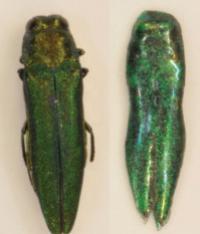
As the emerald ash borer ravages North American ash trees, threatening the trees’ very survival, a team of entomologists and engineers may have found a way to prevent the spread of the pests.
Emerald ash borers (EABs), a type of beetle native to Asia, first appeared in the U.S. about 20 years ago. They are now moving east from Michigan, killing ash trees on the Eastern Seaboard as far south as North Carolina.
“Within 25 years, practically no ash trees may remain on either side of the St. Lawrence Seaway,” said Akhlesh Lakhtakia, Charles Godfrey Binder Professor of Engineering Science and Mechanics at Penn State.
As their name implies, emerald ash borers are iridescent green. The beetles don’t carry disease, but their larvae feed on the ash trees’ sap, effectively killing the trees by depriving trees of their nourishment.
Thomas C. Baker, Distinguished Professor of Entomology at Penn State, knew that the male EAB locates a mate by flying over an ash tree, finding a female by identifying her green wings, which are folded over her back, and then dropping straight down onto her.
Baker and a post-doctoral fellow in his lab, Michael J. Domingue, were using dead female EABs for bait to trap the male beetles. Dead EAB decoys are not ideal for trapping, said Baker, because they are fragile and can sometimes disappear from the trap.
Baker then learned that Lakhtakia was able to replicate certain biological materials, such as fly eyes and butterfly wings. Baker posed the question: could Lakhtakia’s technique visually replicate the unique female borer to create a better lure?
The two researchers, working with a graduate student in Lakhtakia’s lab, Drew P. Pulsifer, created a mold of the top of the female beetle’s body. The decoy beetle is made by a process of layering polymers with different refractive indexes to create the desired iridescence, and then stamping the resulting material into the mold. The researchers were able to create a color similar to the emerald ash borer’s green wings by layering different types of polymer. Eventually they were able to find the right combination of polymers and number of layers in order to refract light and create a color similar to the beetle’s own iridescent green. The researchers’ findings are scheduled to be published in the April issue of the Journal of Bionic Engineering.
“Akhlesh’s technique allows us to present males with different visual stimuli,” said Baker, also a faculty member in the University’s Huck Institutes of the Life Sciences. “We can manipulate more than that, but right now we are experimentally manipulating the visual decoy.”
via Penn State & EurekAlert
The Latest Streaming News: Emerald ash borers updated minute-by-minute
Bookmark this page and come back often
Latest NEWS
Latest VIDEO








